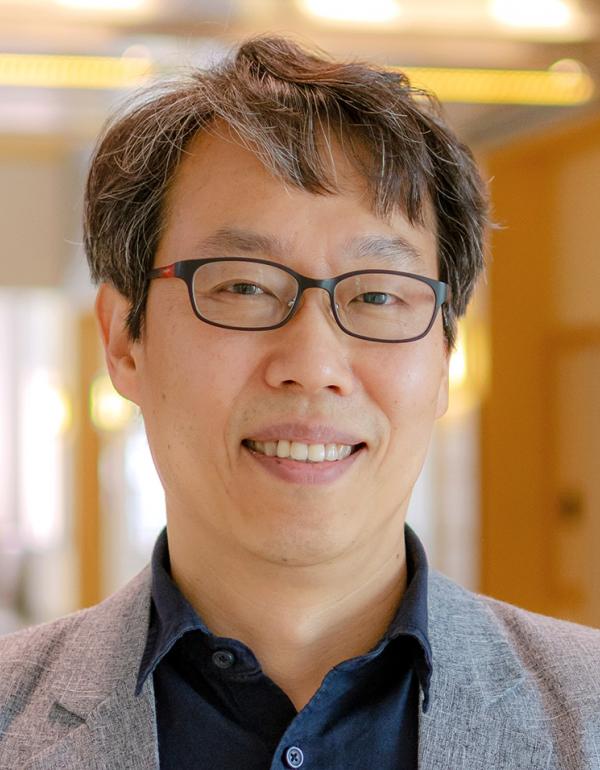
Education
- Seoul National University (Korea), Chemistry, B.S., 1990
- Seoul National University (Korea), Physical Chemistry, M.S., 1992
- Seoul National University (Korea), Organic Chemistry, Ph.D., 1997
Professional Experience
- 1997 – 1999 LG Semicon Inc., Nanolithography, Senior Research Engineer
- 1999 – 2002 University of Florida, Department of Chemistry, Postdoctoral Research Associate
- 2002 – 2008 Assistant Professor, University of Maryland, Department of Chemistry and Biochemistry
- 2008 – 2013 Associate Professor (Tenured 2008), University of Maryland, Department of Chemistry and Biochemistry
- 2013 – present Professor, University of Maryland, Department of Chemistry and Biochemistry, Affiliated position at the Department of Chemical and Biomolecular Engineering and the Department of Materials Science and Engineering
- 2017 – 2018 Associate Chair of Graduate Studies, Department of Chemistry and Biochemistry, University of Maryland
- 2009 – 2020 Invited Adjunct Professor at the Graduate School of Nanoscience and Technology, KAIST (Korea Advanced Institute of Science and Technology), Korea
- 2009 – 2020 Deputy Director, NEES DOE-Energy Frontier Research Center, University of Maryland
- 2017 – present Director of Maryland NanoCenter, University of Maryland
Research Interests
- Electrochemistry of heterogeneous nanomaterials for high power energy storage and ultrafast electrochromics.
- Transport, diffusion, and reaction properties of nanopores.
Major Recognitions and Honors
- 2006 Outstanding Young Investigator Award, KIChE-US (Korean Institute of Chemical Engineers-United States) Chapter at 2006 AIChE national meeting
- 2007 Faculty Excellence Award – College of Chemical and Life Sciences, University of Maryland
- 2008 2007 Invention of the Year Finalist, University of Maryland
- 2010 2009 Invention of the Year, Outstanding Invention of 2009, University of Maryland
- 2015 2014 Invention of the Year, Outstanding Invention of 2014, “Nanopore Battery”, University of Maryland
Significant Professional Service and Activities
- 2007 – 2008 Guest Editor of Nanomedicine for a special focus issue, “Nanoparticles for Cancer Diagnosis and Therapeutics”.
- 2010 – Editorial Board Member of Nanomedicine.
- 2010 – 2011 Guest Editor of Nanomedicine for a special focus issue, “Nanotoxicology”.
- 2012 – 2016 Founding President of Electrodeposition Division, Korean Electrochemical Society (KECS).
- 2012 Science Committee of the 44th International Chemistry Olympiad.
- 2015 – Editorial Board Member of Batteries.
- 2019 – Editorial Board Member of EcoMat.
Materials, Electrochemistry, and Bio-Nanoscience
Our group’s expertise in nanomaterials synthesis and electrochemistry forms the foundation of my research program. With fundamental study on nanotubes, nanowires and nanocrystals, we are interested in growth mechanism and application of such nanostructures at energy storage, catalysis, and biomedical fields. Research projects are; (1) synthesis and characterization of heterogeneous nanostructures with various electronic and/or electrochemical materials and their application to energy storage devices including batteries (Li, Mg, Al) and thin-film 3D solid state batteries, and ultrafast electrochromic display and (2) investigation of fundamental physical and chemical properties of heterogeneous nanostructured materials such as diffusions, reactions, cell interactions.
Synthesis and application of thin film nanostructures and electrochemical study
We have been investigating new electrochemical growth mechanisms of the nanostructures of various materials such as polymers, metal oxides, and metals. The thin nature of nanostructures enable us to design extremely fast charge transport devices. Using the same principle, we are developing high-power high-energy storage devices such as supercapacitors and high power batteries that will also enable fast charge for high energy electric devices both in liquid and solid state systems. In addition, we have extended to other various combination of metal oxides/metals/conductive polymers heterogeneous nanostructures through the mechanistic study of electrochemical deposition/conversion/transformation and atomic layer deposition methods through the collaboration with Prof. Gary Rubloff group at the Dept. of Mater. Sci. Eng. Currently we are expanding our studies to two major areas. Beyond the individual nanostructures and arrays, the close proximity and spacing between nanostructures may raise questions and access phenomena unexpected from the behavior of individual heterogeneous nanostructures both in liquid and solid electrolyte systems. The other area is electrochemical mechanism study on the deposition, conversion, and transformation of hierarchical nanostructures. Hierarchical nanostructures have previously been shown to enhance adsorption, insertion, and conversion reactions that are associated with catalysis, energy storage, energy conversion, chromatography, and chemical sensing. This multi-scale texturization allows for a synergistic joining of two different length scales resulting in performances better than their single architectured counterparts.
Diffusion and reaction problems in a confined geometry of nanostructures
To investigate basic questions surrounding nanofluidics (wetting and dewetting), catalytic reactions and molecular diffusion in a confined nanoscale geometry. We are investigating; (1) Wetting and diffusion problem in well defined pores, (2) Catalytic reactions in a catalyst-anchored nanostructures including nanocrystals and molecular clusters such as polyoxometalates (POMs), (3) Control of atomic layer deposition in nanoscale.
Recent Publications
Sang Bok Lee’s Google Scholar – https://scholar.google.com/citations?hl=en&user=B7JILz0AAAAJ&view_op=list_works&sortby=pubdate
1. “Dual Effect of Structure and Hydration on Magnesium-Ion Insertion into Electrodeposited V2O5 Thin Films,” Hakeem Kimani Henry, Brandon Johnston, Darrin Liau, Emily Sahadeo, Sang Bok Lee, Journal of the Electrochemical Society, 2020, 167, 110523
2. “Probing the electrical double layer by operando X‐ray photoelectron spectroscopy through a graphene‐carbon nanotube composite window,” Peng Wang, Yunfeng Li, Luning Wang, Jacek Kłos, Zhiwei Peng, Nam Kim, Hendrik Bluhm, Karen Gaskell, Ping Liu, Sang Bok Lee, Bryan W Eichhorn, YuHuang Wang, EcoMat, 2020, 2 (2), e12023.
3. “A flexible mesofiber-based fast current collector,” Hakeem K Henry, Junkai Hu, Xiyuan Cheng, Wonseok Hwang, Robert Briber, YuHuang Wang, Sang Bok Lee, Journal of Materials Science, 2020, 55, 11391-11402.
4. “Mg2+ ion-catalyzed polymerization of 1,3-dioxolane in battery electrolytes,” Emily Sahadeo, Yang Wang, Chuan-Fu Lin, Yue Li, Gary Rubloff, Sang Bok Lee, Chemical Communications, 2020, 56, 4583-4586.
5. “Enhancing Lithium Insertion with Electrostatic Nanoconfinement in a Lithography Patterned Precision Cell,” Sylvia Xin Li, Nam Kim, Kim McKelvey, Chanyuan Liu, Henry S. White, Gary W. Rubloff, Sang Bok Lee, Mark A. Reed, ACS Nano, 2019, 13, 8481-8489.
6. “High-capacity lithium sulfur battery and beyond: a review of metal anode protection layers and perspective of solid-state electrolytes,” Yang Wang, Emily Sahadeo, Gary Rubloff, Chuan-Fu Lin, Sang Bok Lee, Journal of Materials Science, 2019, 54, 3671-3693; doi:10.1007/s10853-018-3093-7


